How to do Content Gap Analysis: The Complete Guide
Content marketing is all about coming up with fresh and valuable content ideas, which is a constant challenge, and I Love challenges like you.
Table of Contents
ToggleI want to provide information that educates and engages the audience, but this is not my only motto. I also want to attract huge traffic from search engines by targeting valuable keywords and want to rank for them.
Your problems can solved by this one strategy- “Content Gap Analysis.”
One smart strategy for creativity is to analyze your top competitor’s content. By using this strategy and including topics that are not available in your competitor’s content, you can swoop in and steal traffic by filling the voids. So chill and Read this article till last.
This process of exploring competitor’s content strategies to find opportunities is known as content gap analysis
Read on to learn what content gap analysis is, why it’s valuable, and how to do a Gap analysis to find traffic-stealing topics that are missed.
Backlinko research of Google’s key ranking factors found that the average first-page result contains 1,447 words. Search engines value in-depth, high-quality content, so always prioritize Quality over quantity.
You May also like: 29+ Group buy SEO Tools Providers in India
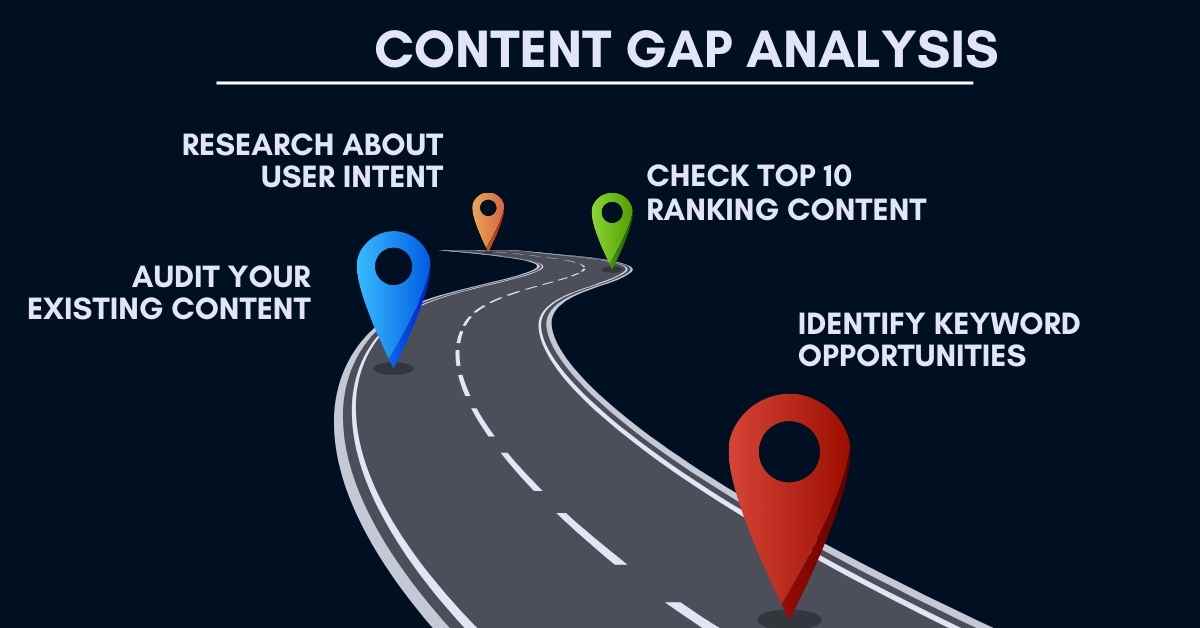
What is Content Gap Analysis?
Content gap analysis is all about finding those juicy content opportunities that align perfectly with the different stages of your target audience’s buying journey.
It’s like having a secret roadmap to your audience’s desires and pain points.
With this process, you can easily pinpoint the areas where your content is falling short. And by filling those gaps?
Well, let’s just say you’ll be the one rocking it while your competitors are left scratching their heads in shock (just kidding, but a little friendly banter never hurt, right?).
This analysis will reveal the content sweet spots where you can really bring the value and helpful goodness that your audience craves. And you know what? Google absolutely loves that kind of high-quality, audience-pleasing content.
With this process, you can easily find the areas where you are lacking and by filling it you can easily outrank your competitors, which means You ROCKED, Competitor SHOCKED,(just kidding).
This analysis will help you to find in which content you can add value that will be helpful for use and of course, google loves that.
Guys, My website’s traffic was fluctuating, and my heart was beating fast. You Know without this up-and-down graph, we can’t learn new things and accept challenges.
GSC is the best way to find queries for which you can also rank, and because of new keywords, your content looks like more refreshing. is it not good?
These content gaps represent huge opportunities for you to steal search traffic from your competitors. By creating high-quality content that fills the gap, you can target valuable keywords where competitors are either-
- Not ranking at all
- Ranking poorly
- Only providing superficial, low-value content
Overall, gap analysis is a data-driven way to generate strategic content ideas that attract search traffic and cater to your audience.
What are the Types of Gap Analysis?
The two main types of gap analysis are:-
Keyword Gap Analysis
It focuses specifically on hunting in which your competitor’s article is ranking in search engines, but you didn’t target that keyword.
This process will help you find new keyword opportunities to rank that you may be missing out on, and including that keyword in your content will improve your search visibility.
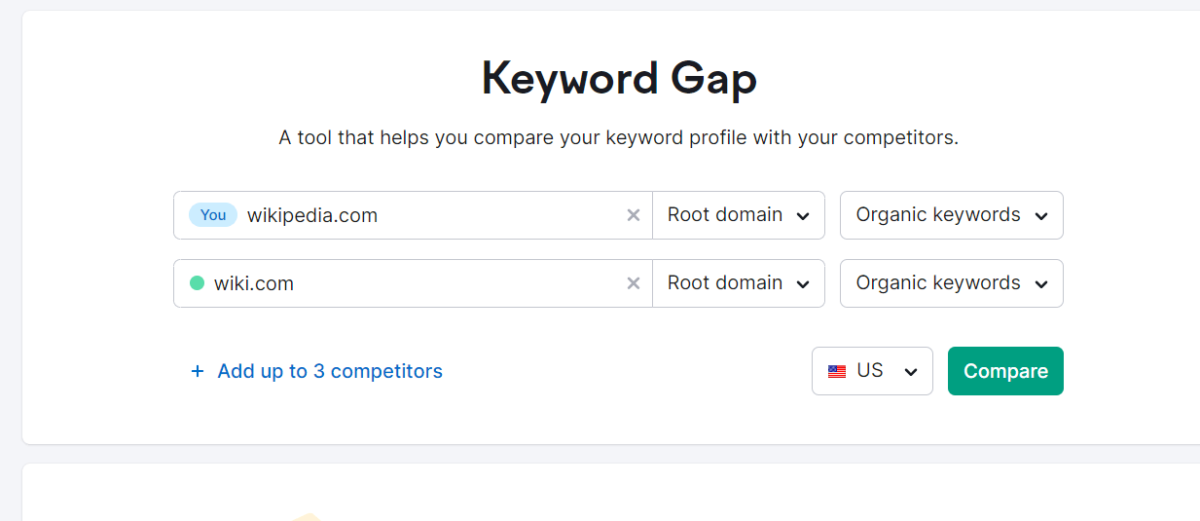
You May also like: 15 Proven Content Marketing Strategies to Improve SEO
Content Gap Analysis
Now, the Content Gap Analysis is a broader approach by finding the overall topics, themes, and content areas that your competitors are covering but you’re missing.
It goes beyond just keywords and looks at the actual subject matter and content types (e.g., blog posts, videos, guides) that your competitors are producing.
Both types of gap analysis are valuable and complementary. Keyword gap analysis will automatically improve your overall SEO efforts.
On the other hand content gap analysis can help you create a more comprehensive and competitive content strategy that satisfies your user’s craving quickly (hehe).
What is a SWOT Gap Analysis?
This is the best and strategic tool and the collab of traditional SWOT (Strengths, Weaknesses, Opportunities, Threats) analysis with a gap analysis approach is just fire.
With the help of this, you can find the gaps between an organization’s current state and what they actually want, as well as the internal and external factors that may impact its ability to bridge those gaps.
Here’s how a SWOT gap analysis works:-
Strengths- Be hone and don’t be biased while checking your organization’s internal strengths that can help you fill those gaps and achieve your desired goals. I can be anything like your fab team, powerful products, or a loyal customer base.
Weaknesses- It is an important task and find out your internal weaknesses or limitations that might trip you up on the path to gap-closing greatness. For example, like outdated tech, high turnover, or limited cash flow.
Opportunities– Now it’s turn to look outward at the external opportunities and favorable factors you could take advantage of to bridge the gaps easily. It can be anything from new market gaps to strategic partnerships to customer needs.
Threats- Hmm, You know we have to keep our eyes in every direction to find your enemies. So, Keep an eye on those external threats or unfavorable conditions that could stop you. Keep updated with Increased competition, economic downturns, regulatory changes etc.
Gap Analysis- After taking all the above steps, you can start work on your strengths, weaknesses, opportunities, and threats. Then, you can start digging out specific gaps or misalignments between your present situation and your Goals. No sugar-coating allowed!
Action Plan- In the end, after doing that deep gap analysis, Now it’s your turn to be strategic with an action plan for filling those gaps. you have to focus on How you can double down on strengths, hunt your weaknesses, seize opportunities quickly, and manage threats. Map it out and get to work!
You May also like: 10 Best AI Content Writing Tools (Write Faster and Better)
What are the Types of Content Gaps?
There are Different Types of content gaps and it is important to understand them for make and effective strategy.
Here are some common types of content gaps:-
Topic Gaps- As you can understand these are content areas or subjects that your competitors have covered, but you are missing that piece.
You can understand it with the help of an example that if your competitors have In-depth content on “eco-friendly travel,” but you did not cover that topic, it represents a topic gap.
Keyword Gaps- As I already mentioned above keyword gaps are the specific keywords or phrases for which your competitors are ranking but you are not. Finding and targeting these missing Puzzles can help improve your Rank on SERP.
Content Type Gaps- Stay updated with trends, this is not advice it’s warning! You will fall behind when your competitors are serving content in trending formats that you are missing.
For example, if your competitors are also giving valuable video content, but you only focus on written blog posts, that’s a content-type gap.
Format Gaps– This is the most simple thing to do. You have to serve your content in the most attractive way.
If you have written a blog post on the same topic as your competitors, but there may be gaps in the formatting or presentation, it may be difficult to increase your ranking. If you are not using infographics, relevant and rich images, and videos.
Quality Gaps- Quality and richness matter a lot in content. Your competitors may create more comprehensive, authoritative, or valuable content on these topics, leaving you with a quality gap. You have to fill these gaps with your targeted terms.
Audience Gaps- Your Target Audience for which you are writing, Gaps also exist in the form of the target audience segment.
Your competitors may be creating content tailored to specific audience segments that you’re not catering to, resulting in an audience gap.
You May also like: 13 Best Ways to find Great Content for Blog
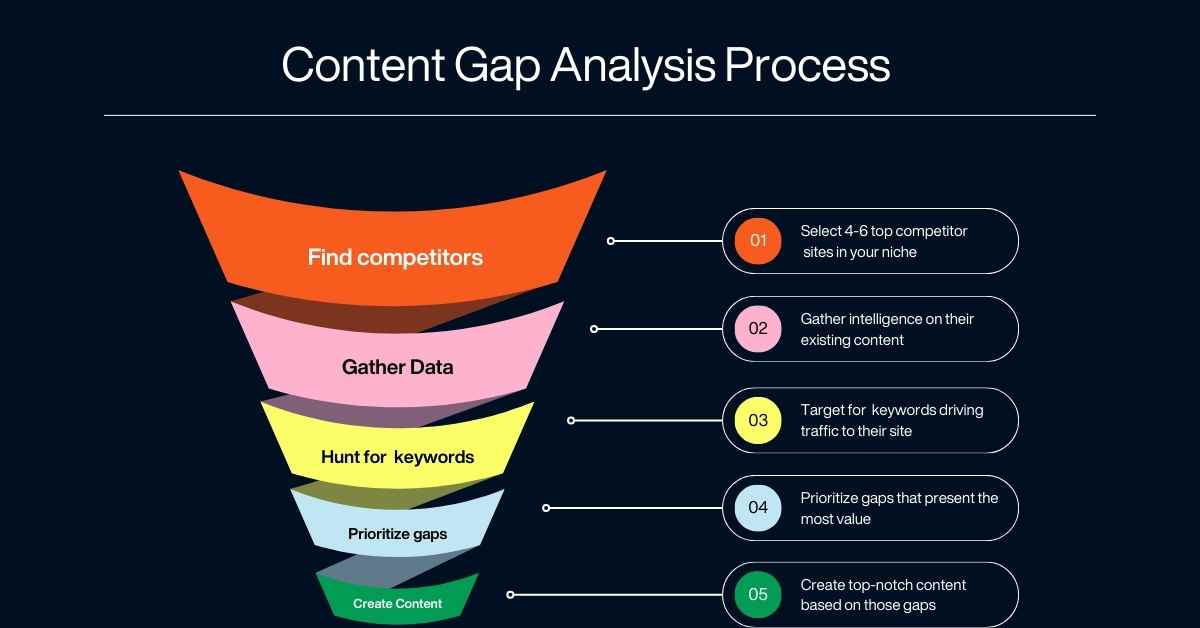
How do you fill the Content Gaps?
If you have sharp eyes then you can easily find the content gaps, Do it with the right strategy and make a plan to fill the gaps and more strengthen your content strategy.
Here are some steps you can take:-
Prioritize the Gaps- Priority matters in your tasks. Do not focus on all tasks at once, not all content gaps are equally important or impactful. Give Priority to factors such as search volume, target audience, and potential for driving traffic and conversions.
Create a Content Calendar- It’s important to create a content calendar that outlines the topics, content types, and formats. This calendar is very useful in filling those gaps. Include deadlines, responsible parties, and any necessary resources or budgets in this calendar.
High-Quality Content- As you know, Content is KING! If you’re creating valuable content to fill the gaps, be focused on producing high-quality, valuable, and engaging content that meets your user’s needs.
Make your content well-researched, Infor-rich, a problem-solving topic, and easy to understand or digest.
Optimize for Search and User Experience– Properly optimize your content for search engines, using relevant or LSI keywords and meta tags and doing proper on-page SEO. Make your content user-friendly, easy to skim, visually catchy, and easily shareable.
Promote and Distribute- Now, Your Content is Ready now focus on promoting it. Share it on social media and you can use some writing platforms like medium and reddit to promote it. Email marketing, influencer outreach, and create a buzz.
Modify it as Need- Based on your analysis, Make your content strategy. Don’t forget to update existing content, you can also create new content to fill the remaining gaps.
How to Fix Content Gaps?
Strategies to address content gaps:-
Audit your existing assets and gaps to understand them.
- So many methods are available to repurpose and update your high-performing content into new formats like (infographics, cheatsheet and mindmaps.)
- Collaborate with subject matter experts or guest contributors for their expertise.
- Curate relevant third-party content to temporarily fill gaps.
- Don’t compromise with quality and be consistent.
- User-generated content from your audience.
- Continuously monitor and adapt your strategy as needed.
By this, you can fill content gaps, provide a well-researched content to your audience, and drive better engagement, and conversions.
You May also like: On-Page SEO in 53 Steps: Powerful Guide to Boost Your Rankings
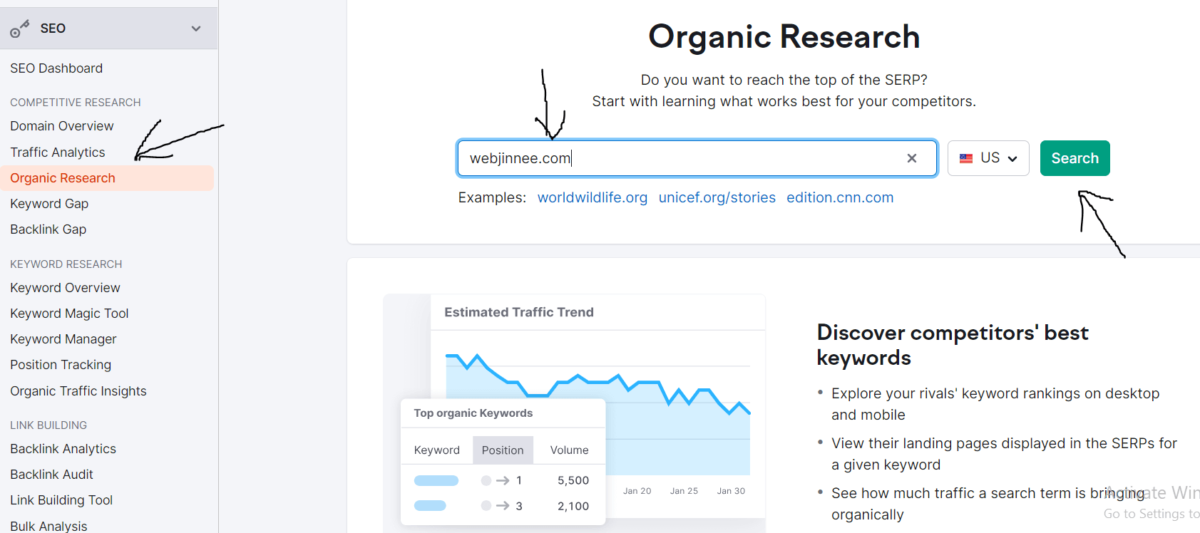
How to Conduct a Content Gap Analysis
Successful long-term competitive content analysis takes some effort and energy (so start it with an energy drink), but it provides priceless insight into overlooked opportunities.
Let’s take an example of a fictional fitness apparel company, FitGear, that dedicatedly focuses on improving its content marketing strategy and better engagement with its target audience.
Now, FitGear has to follow these steps-
Make a Persona of the Target Audience and set Goals
The company’s target audience could include fitness enthusiasts, athletes, and health-conscious people between the ages of 25 and 45.
The Main Goals should be:-
- Establish Brand ‘FitGear’ as a thought leader in the fitness industry and focus on brand awareness.
- After increasing awareness, focus on driving qualified traffic to their website and automatically, sales will increase.
- Lead Magnet helps build a loyal community of fitness enthusiasts (Make a Loyal community).
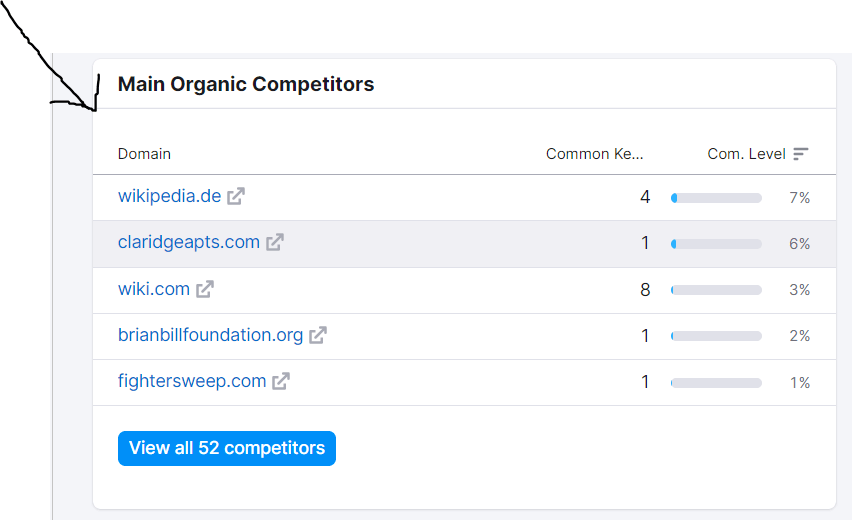
Find your key competitors
Start by making a list of 4-6 of your top competitor websites in your niche. These should be companies actively vying for the same audience and keywords as you, so keep an eye on them.
For example, if you sell dog toys, key competitors might be other dog toy manufacturers or pet supply e-commerce stores.
Gather Data from their content
To know what your competitor is doing to rank high, you have to spy on their content, such as guides, blogs, and other content assets, to get an overall idea of their thoughts.
Make a note of:-
- What content formats are they using – articles, videos, ebooks etc.
- The volume of their content output
- Their content categories and themes
- Their most shared and linked-to content
- You can use tools like BuzzSumo, Semrush, Ubersuggest and Ahrefs to analyze competitor’s content.
Research keywords and traffic
- Dig deeper to pinpoint the specific terms and topics that are driving traffic to competitors.
- Use keyword research tools to find out
- Their highest-ranking pages in search results
- The keywords sending traffic to these pages
- The search volume of these terms
- This reveals strategic keywords where competitors are outranking you.
Audit Your Existing Content
FitGear has an existing content inventory consisting of-
- 50 blog posts (mostly product-focused)
- 10 workout videos on YouTube
- 5 fitness guides/ebooks
- What is their strategy on Social media (Instagram, Facebook, Twitter)
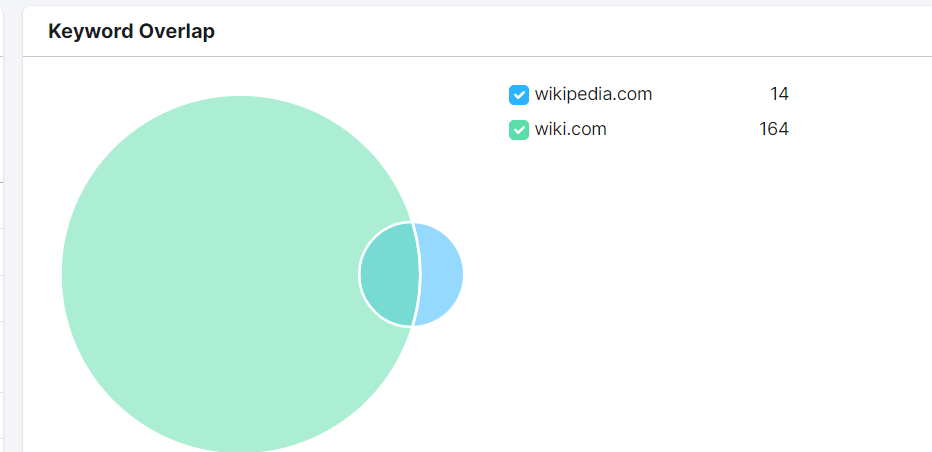
Find Hidden Topics
Now, match up your findings on competitor’s content against your strategy.
Look for-
- What relevant topics have they covered that you’ve overlooked
- Keywords they are ranking well for that you haven’t targeted
- Specific angles they have written on that your content is missing
- Ways they present similar content with a unique twist
- Any area where competitor’s content better targets audience interests and search intent represents a gap to fill.
Research Your Audience’s Interests and Search Behavior
Using keyword research tools like Ahrefs, Semrush, Ubersuggest and Google Trends, FitGear Finds that their target audience is actively searching for topics related to-
- Best workout routines and exercise techniques (e.g., “best leg workouts,” “proper squat form”)
- Nutrition and diet plans for athletes (e.g., “high-protein meal plans,” “keto diet for beginners”)
- Fitness tips to be in perfect shape and motivation (e.g., “morning workout motivation,” “fitness tips for busy people”)
- Injury prevention during exercise and recovery tips (e.g., “prevent knee pain during squats,” “recovery tips for sore muscles”)
- After the research, they found that their audience is interested in different content formats, such as instructional videos, infographics, Cheetsheat and podcasts etc.
Brainstorm targeted content ideas
For each content gap you recognize, brainstorm fresh content ideas for those missed topics and keywords.
Come up with blog posts, guides, and other content formats that would resonate with your audience while stealing traffic from competitors.
For example, if competitors are ranking well for “dog toy reviews” but you haven’t published any, create a plan for a review-based content series.
Find Content Gaps
By comparing its existing content inventory with their audience’s interests and search behaviour,
FitGear Discover several content gaps-
- Lack of in-depth, high-quality content on workout routines, exercise techniques, and fitness tips.
- Limited content on nutrition, diet plans, and healthy eating habits.
- No content addressing injury prevention and recovery, which is a major concern for their audience.
- Lack of diversity in content formats, with a heavy focus on blog posts and minimal use of videos, infographics, or podcasts.
Prioritize the most valuable opportunities
Not all content gaps present equal opportunities. With your list of ideas in hand, prioritize pursuing gaps that-
- Relate to topics your audience clearly cares about
- Target keywords with decent search volume
- Represent the biggest areas of deficiency on your site
- Give so much value where your competitors are lacking
- This ensures you focus your efforts on gap-filling content with the greatest ROI.
Analyze Competitor Content
FitGear researches the content strategies of their biggest competitors, such as Nike and Lululemon, and finds that-
Nike has a strong focus on inspirational and motivational content. They share stories and lifestyle content from the best athletes.
Lululemon is truly focused on healthy living lifestyle, covering topics like mindfulness, nutrition, and self-care tips in different formats.
They find out that both competitors have a Variety of content on their websites, including step-by-step videos, podcasts, and interactive tools like workout builders and calorie calculators.
You May also like: How to do Keyword Research for SEO: Never Fail Techniques
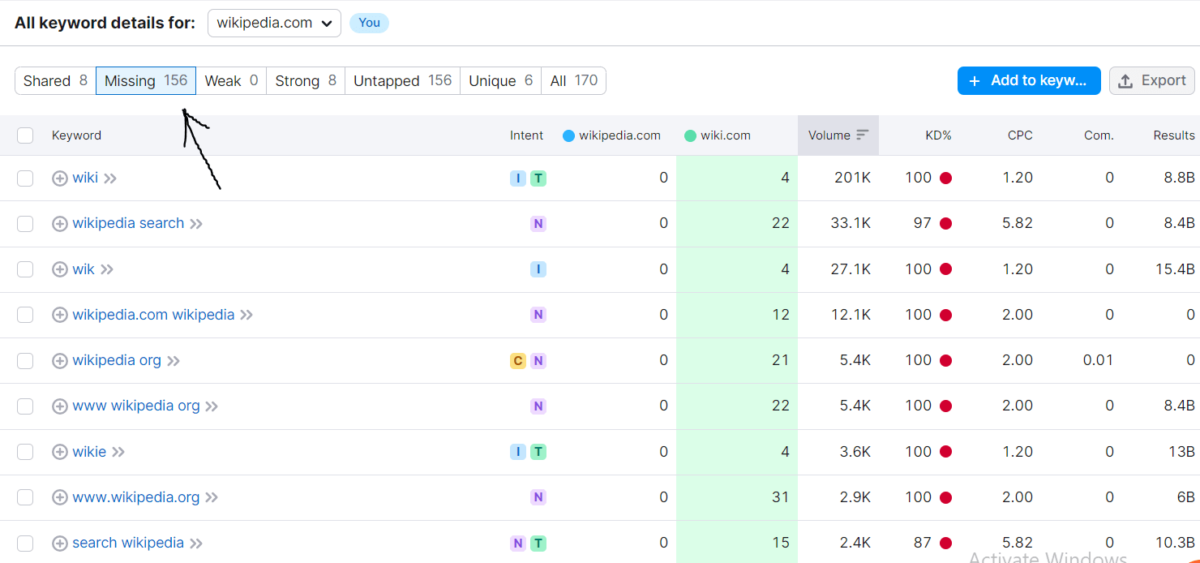
Develop a Content Plan
Based on their gap analysis findings, FitGear developed a content plan to fill the gaps:-
They focus on creating a series of complete workout guides in easy steps and step-by-step videos in which they cover various exercise routines and techniques.
They Design a dedicated “Nutrition Hub” with meal plans for each category, recipes, and educational content fir a healthy lifestyle.
They invite fitness experts to their podcasts to share their inspirational journey with their users.
Experts discuss injury and harmful mistakes that beginners may make and give suggestions about how to recover from that stage.
They serve content more engagingly and creatively to attract users and develop some interactive tools (e.g., workout trackers, calorie calculators) to engage with their audience.
Continue creating motivational and inspirational content featuring real FitGear customers and athletes.
Produce high-quality content that fills the gaps
The Next and most important step is to create stellar content optimized around the gaps your competitors have left open.
For each piece, ensure you-
- Focus on topics and keywords identified in your analysis
- Thoroughly answer audience questions and address pain points (FAQ)
- Provide more value than competitors currently offer (stay ahead)
- Promote the content so it actually reaches and engages your audience
- Gaps only represent an opportunity if your content is better than what currently ranks. Use your competitor’s deficiencies to inspire great content.
Monitor Analytics and Implement
After implementing their content plan for three months, FitGear measures the performance of their new content:-
Their workout guides and videos have driven a 35% increase in website traffic and a 20% increase in engagement rates (time on page, social shares, etc.).
But Don’t stop there. Stay updated with trends and monitor analytics. Update content according to users craving.
You May also like: 9 Best GPL Websites for WordPress (Plugin Just Rs. 99/-)
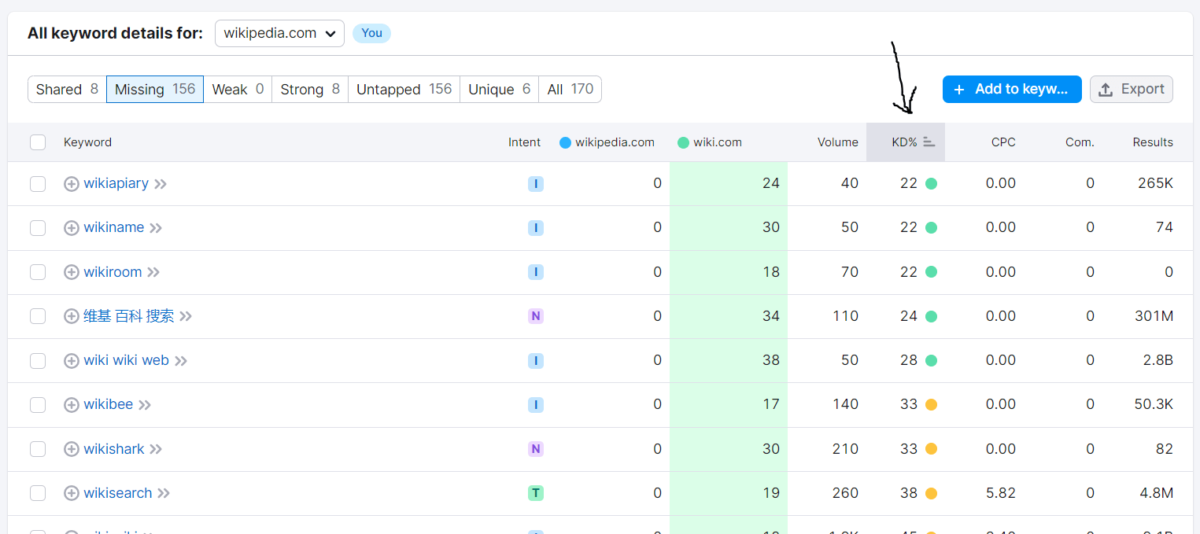
Key Benefits of Content Gap Analysis
Performing regular content gap analysis provides a wealth of advantages:-
- Find Untapped Keyword Opportunities
Gap analysis reveals valuable, high-traffic keywords that competitors are targeting that you have missed, so by this, you can outrank competitors with better content.
- Gain a Competitive Edge
By creating the infor-rich content that your audience wants but your competitors don’t offer, you can seize an opportunity.
- Understand Your Audience Better
Analyzing competitors’ content reveals user search behavior and interests with which you may not be aligned currently.
- Lower Content Creation Costs
Filling in the gaps allows you to use competitor’s ideas rather than starting from scratch.
- Build Domain Authority
Targeting topics that competitors are missing can strengthen your site as a trusted resource and boost domain authority.
- Save Time With Better Ideation
With the help of this, you will get a strategic framework for brainstorming rather than guessing content topics.
- Maximize Value For Readers
Filling gaps provides information your audience desperately wants but is not available elsewhere.
- High Ranking In Search Engines
Owning niche topics that competitors overlook can help you surpass them in rankings.
Overall, regular content gap analysis gives you more opportunities to rank for primary keywords that your users want.
Best Tools for Content Gap Analysis
Certain tools can streamline researching competitor’s content and Find strategic gaps-
SEMrush
SEMrush provides robust competitor content analysis, including keyword rankings, search traffic data, and top-performing content.
Ahrefs
Ahrefs Content Explorer provides deep insight into competitors’ content strategies, which can help you to stay ahead of the competition.
BuzzSumo
BuzzSumo analyses trending content performance to reveal resonating topics to cover.
Ubersuggest
Ubersuggest generates relevant keyword ideas to find missed opportunities.
Google Analytics
Review your own GA4 data for insight on current content strengths and weaknesses.
Answer the Public
This tool reveals the questions your audience is asking online to suggest gap topics.
You May also like: 15 Common Technical SEO Mistakes to Avoid
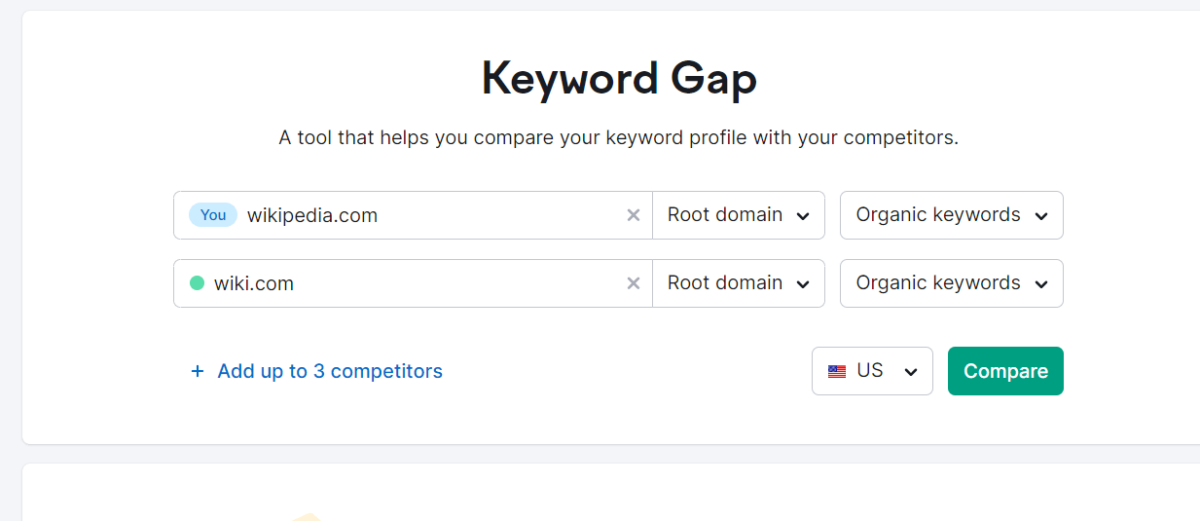
How to Do Gap Analysis in SEMrush?
SEmrush is the best industry content gap analysis option. It helps you find the topics and content keywords for which your competitors are ranking, but you missed the piece of the puzzle.
By doing this analysis, you will have valuable insights about which types of content you should create to stay ahead and meet the expectations of your users.
To conduct a content gap analysis in SEMrush, follow these steps:-
Step 1: Log in to your SEMrush account and navigate to the “Organic Search” Option to find your competitors.
Step 2: Click on the Enter
Step 3: Go to Main Organic Competitors
Step 4: View all pages and download it
Step 5: Now, Go to the Keyword Gap Tool
Step 6: Enter your domain name and your competitor’s domain.
Step 7: Now, Click on the Compare and Boom!
All Keyword details will be shown here. To find missing keywords, click on Missing and select the KD. You can also choose untapped, weak, strong, or unique keywords.
You can save the file or download it for later.
You can export the content topic data from SEMrush to a CSV or Excel file for further analysis and prioritization.
Based on the prioritized content topic list from the gap analysis, you can make a content creation plan to fill the gaps. This could involve creating new blog posts, guides, videos, or other content formats to cover the missing topics.
What is the difference between keyword gap and content gap analysis?
Keyword Gap Analysis-
Both have different types of use, Keyword gap analysis focuses on finding the keywords for which your competitors are ranking but you aren’t.
It is very helpful to find new and trendy keyword opportunities that you may be missing out. The goal of this analysis is to find gaps and find potential keywords for which you can optimize your content.
The keyword gap analysis provides insights into-
- Keywords your competitors rank, but you don’t
- Keyword rankings and positions for shared keywords
- Search volumes and keyword difficulty levels of targeted keywords
Content Gap Analysis-
On the other hand, content gap analysis is all about hunting for the broader topics that your competitors have covered but you haven’t. It’s not just about any targeted keywords.
This approach takes a much broader look at the actual themes and subject matter that your competitors are putting out there.
The content gap analysis provides insights into-
- Content topics and themes covered by competitors but not by you
- Content types (e.g., blog posts, videos, guides) that competitors are producing
- Content areas where you have an advantage over your competitors
Both types of analyses are valuable. By filling these missing keyword gaps, your search engine ranking will improve, while filling these content gaps will better align your content strategy with your audience’s crave. As a result, your content will drive more engagement and conversions.
You May also like: 249 Free Blog Submission Sites list (High DA-PA)
Key Questions For Content Gap Identification
Keep these questions in mind when analyzing competitor’s content for gaps:-
- What topics are their top-performing pieces of content covering?
- What specific keywords are driving traffic to their site?
- What search terms related to our niche do they rank highly for?
- What content formats (articles, videos, etc) perform best for them?
- What kinds of titles, angles, and topics resonate based on social shares?
- How in-depth is their content? Does it fully satisfy user intent?
- What queries are people entering that their content doesn’t target?
- Where do they fall short in fully covering a topic our audience cares about?
- What areas of our industry does their content neglect?
- What topics are nowhere to be found on their site?
When you ask the Right types of Questions the best strategic content you will get. This will help you to think like a detective to find hidden content opportunities.
Quickly do Content Gap Analysis Process
Here is a quick recap of the gap analysis process:-
- Select 4-6 top competitor sites
- Gather intelligence on their existing content
- Hunt for keywords driving traffic to their site
- Compare their content coverage to your content
- Pinpoint topics and keywords they are targeting that you are not
- Brainstorm ideas for content to fill those gaps
- Prioritize gaps that present the most value
- Create top-notch content based on those gaps
- Promote your new gap-filling content to steal your competitor’s traffic
- Following this framework regularly will keep you stocked with strategic ideas.
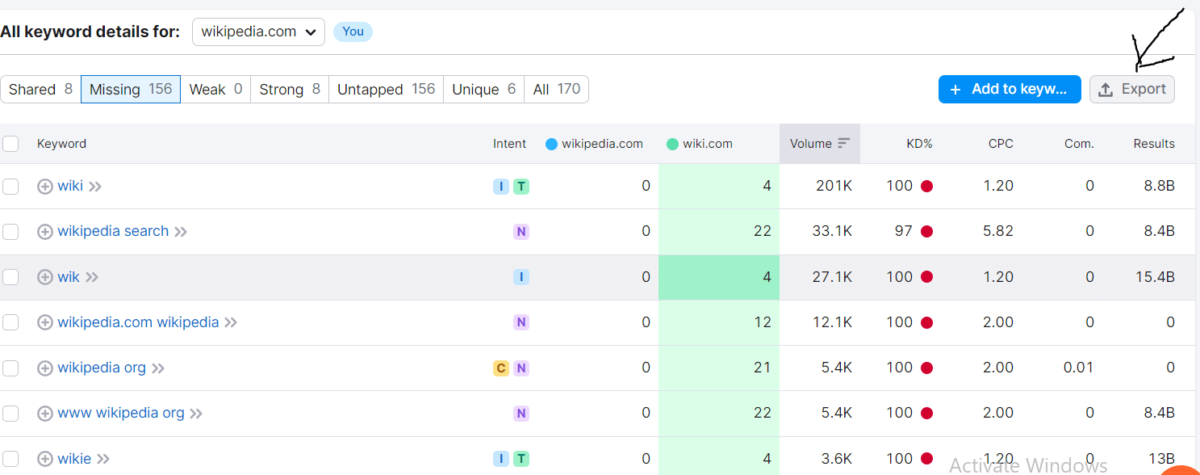
Common Content Gaps to Target
Each niche has a different potential, these are common content gaps that are regularly found across topics:-
- Basic explainers- Competitors often lack simple “Content 101” content for newbies to a topic. Now you have a chance to create educational overviews targeted to first-time learners who can fill a need.
- Current events/News- Tying content to real-time happenings related to your niche fills a gap for audiences seeking timely information.
- Industry studies/research- Add the Latest data from surveys, reports, and expert findings in your content to make it more authentic.
- Product comparisons- Writing detailed information bout comparisons of product features and benefits can sway customer purchase decisions and fill gaps left by superficial reviews.
- Contrarian views- Offering an alternative stance to competitor’s prevailing messaging taps into search intent they are ignoring.
- Local/niche focuses- Go down into geographic or niche subtopics within your category can fill gaps.
- Diverse formats- To stay ahead of Competitors, try different content types. Like infographics, podcasts, or interactive tools to fill format gaps.
- Interviews/expert advice- Content that features insights and suggestions from reputable professionals provides a more engaging spin.
- Addressing pain points- Maybe Competitors tend to focus on selling solutions rather than addressing user challenges. Discussing common pain points of your audience to fills a huge gap.
- “How to” guides- Actionable, step-by-step guides for skill development or solving problems are invaluable to audiences and build trust.
- Relatable scenarios- Personal stories and relatable analogies make content more digestible, and engaging.
- Surprising facts/stats- Providing shocking data and research facts uniquely captures attention.
How to Optimize Content to Fill Gaps?
Once you know what content gaps you have to target, Make sure your execution is on point.
Optimize around these factors:-
- Laser-focus your topic. Stay dedicated to the specific gap and keywords you intend to fill rather than diluting ideas.
- Deliver true value- Provide actionable advice, step-by-step guide and clarity on which competitors are lacking – don’t just publish content for its own sake.
- Unique and compelling angle- Come at the topic from a different perspective, which readers won’t find elsewhere.
- Authoritative expertise- Establish your credibility on the topic with actionable best practices.
- Engaging visuals- Use relevant data visualizations, diagrams, and images to create more impact.
- Visual elements- Include videos, audio or trendy format of content to make static posts more interactive.
- Current data/examples- Freshen up existing topics with up-to-date statistics and real-world examples.
- Careful keyword optimization- You have to fill those keyword gaps appropriately without over-optimizing.
- Comprehensive but concise- Give readers the details and context they need while cutting fluff.
- Promotion and amplification- Getting gap content in front of the right audience is critical for traffic stealing. Promote it strategically across your website and social handles.
You May also like: 15+ Best Etsy SEO Tools (Free & Paid)
Limitations of Content Gap Analysis
While an immensely useful strategic tool, content gap analysis does have some limitations to be aware of-
- It takes so much effort and strategy to thoroughly analyze competitors at scale.
- Not all keyword gaps are opportunities, research about it before choosing. So choose it wisely.
- You may need unique access to proprietary data or niche expertise to properly fill specific gaps.
- Some gaps are better left unfilled if they diverge too far from your brand positioning.
- Competitors may shift strategies and fill the gaps before you get the chance.
- There is no guarantee content will convert well even if it fills a gap.
- Treat gap analysis as one tool of your ideation process rather than the only factor. But used regularly, it reliably surfaces fresh, strategic content ideas rooted in data.
Turning Gaps Into Opportunities
At the end of the day, content gap analysis is about Finding openings to provide value to readers that your competition has overlooked. The gaps represent an opportunity to publish content that is:
- Helpful and educational for your audience
- Aligned with search intent and customer interests
- Different from the saturation of content competitors are already producing.
- Effective enough in potential traffic volume to deserve the following
- Look for gaps with the greatest overlap across these criteria – topic areas where covering a specific need or question can simultaneously steal search traffic while serving your audience.
Conclusion
NOW, Start Stealing Traffic Today!
With the help of a detailed content gap analysis strategically you can find untapped opportunities that you have missed and easily steal your competitors’ traffic.
With this, you can easily find the topics, content types, and keywords that your competitors are ranking for but you’re not. Is that not sad?
Now, you can create a targeted and valuable content plan that fills those missing gaps, positioning your business as an authority in your industry.
One thing you should remember is that gap analysis is not a one-time task; you should have to do it regularly. But before that, analyze Search trends, user behavior, and your competitors’ constantly evolving strategies.
While good originality requires looking inward at your own audience data and content performance, gap analysis forces you to look outward. Mining the content landscape for openings you can capitalize on leads to content that attracts, engages, and converts readers.
The more time you take or wait, the more likely competitors will catch on and plug their gaps. So start researching, analyzing, and brainstorming new gap-filling content ideas right away.
I am sure that it will drastically boost your organic reach, and then stealing traffic is just a few gaps away. All the BEST!


